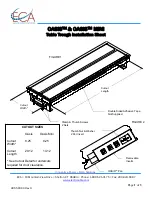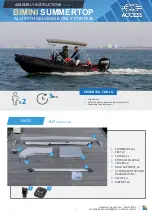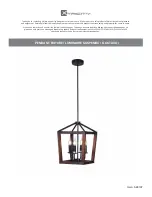
Page 21 of 36
P/N 595289-01 Rev B 5/15
9. To check the pre-alarm, leave respirator motionless for twenty (20) seconds.
The green flashing light shall be replaced by a red flashing light. An ascending/
descending tone will sound increasing in volume. Leave the respirator motionless.
10. After the pre-alarm condition occurs, check the pre-alarm reset. Within twelve
(12) seconds of the pre-alarm, move the respirator to activate the motion sensor.
The SEMS II distress alarm shall reset to sensing mode. The red flashing light
shall be replaced by a green flashing light and the ascending/descending tone
shall stop.
Continue with regular operational inspection of respirator as directed by respirator
instructions or your approved respiratory protection plan procedure. During the
inspection the respirator must be moved or turned every thirty (30) seconds or
less to prevent the sounding of the full alarm.
After completion of all respirator checks and before turning off the cylinder
valve:
1. Check the manual reset of the pre-alarm. Leave the respirator motionless until
pre-alarm condition occurs. Within twelve (12) seconds press and
single
click
the reset button. Three (3) chirps shall sound, then release button. The distress
alarm shall reset to sensing mode and the alternating flashing red lights will be
replaced by a flashing green light.
2. To check the full alarm, leave the respirator motionless until the pre-alarm condi-
tion occurs. Do not reset.
a) The full alarm shall sound a loud almost continuous tone accompanied by
simultaneous flashing of the red signal lights on the control console.
b) The PAK-TRACKER Hand Held Receiver will sound an alarm and display the
Identification Number of the SEMS II distress alarm. The displayed number
will be either the Sensor ID number which appears on the label on the Sensor
Module or the ID number programmed using the SEMS II RFID Tag. Use the
SCROLL button on the Hand Held Receiver to highlight the active ID number
and press the ENTER button on the Hand Held Receiver to select the displayed
ID number. Point the unit directly at and in close proximity to the respirator.
The signal strength displayed will be at its highest value.
4. Reset the full alarm by pressing
twice
on the reset button located on the side of
the control console
(fully depress reset button, release and press again).
a) The loud alarm shall stop. The unit will sound three chirps and the green light
will flash. The unit shall reset to sensing mode.
b) The PAK-TRACKER Hand Held Receiver will reset to its non-alarm state.
5. Finish all respirator checks involving air flow and turn off the cylinder valve. Use
the purge valve to release all residual air pressure in the system.
With the cylinder valve OFF:
1. Check the continuing operation of the distress alarm. The distress alarm shall
remain active with green light flashing. Do not move respirator, pre-alarm shall
occur with twenty (20) seconds. Move respirator slightly, pre-alarm shall reset,
green light shall start flashing again.
2. To turn the distress alarm off, press the reset button
twice
(press, release and
press again). If there is air pressure left in the system, the green flashing light will
continue to flash while a fifteen second beep sequence is heard from the sen
-
sor module as the residual air bleeds from the system. As soon as the air has
completely bled from system, the unit will sound a quick two tone chirp and the
PASS DEVICE distress alarm will be inactive. If there is no pressure in the system
when the RESET button is pressed twice, there will be no beep sequence. The
distress alarm is now in the “OFF” condition. If there is air pressure in the system,
the PASS DEVICE distress alarm will return to the active mode.
NOTE
IF THE LOW BATTERY INDICATION (ONE STEADY CHIRP EVERY TWO (2) SEC-
ONDS WITH NO FLASHING LIGHTS) OCCURS AT ANY TIME DURING REGULAR
OPERATIONAL INSPECTION, DO NOT USE THE RESPIRATOR. CHANGE THE BAT-
TERIES IN THE SENSOR MODULE IMMEDIATELY AND REPEAT THE REGULAR
OPERATIONAL TEST OR TAKE THE RESPIRATOR OUT OF SERVICE UNTIL THE
BATTERIES ARE CHANGED AND THE REGULAR OPERATIONAL TEST IS SUC-
CESSFULLY PERFORMED.
FORMED.
If any operational problems are found during the REGULAR OPERATIONAL INSPEC-
TION, do no use the respirator. Remove the respirator from service and tag for repair
by authorized personnel.
WARNING
FOLLOW REGULAR OPERATIONAL INSPECTION
PROCEDURE EXACTLY. IF THE SEMS II
DISTRESS ALARM DOES NOT ACTUATE, OR IF
ANY OTHER FEATURE DOES NOT OPERATE AS
DESCRIBED OR IF ANY OTHER OPERATIONAL
MALFUNCTION IS NOTED, DO NOT USE THE
RESPIRATOR.
WARNING
IF THE LOW BATTERY INDICATION (ONE
STEADY CHIRP EVERY TWO (2) SECONDS
WITH NO FLASHING LIGHTS) OCCURS AT
ANY TIME DURING REGULAR OPERATIONAL
INSPECTION, DO NOT USE THE RESPIRATOR.
CHANGE THE BATTERIES IN THE SENSOR
MODULE IMMEDIATELY AND REPEAT THE
REGULAR OPERATIONAL TEST OR TAKE THE
RESPIRATOR OUT OF SERVICE UNTIL THE
BATTERIES ARE CHANGED AND THE REGULAR
OPERATIONAL TEST IS SUCCESSFULLY
PERFORMED.
WARNING
FOLLOW REGULAR OPERATIONAL INSPECTION
PROCEDURE EXACTLY. IF THE SEMS II
DISTRESS ALARM DOES NOT ACTUATE, OR IF
ANY OTHER FEATURE DOES NOT OPERATE AS
DESCRIBED OR IF ANY OTHER OPERATIONAL
MALFUNCTION IS NOTED, DO NOT USE THE
RESPIRATOR.
















































